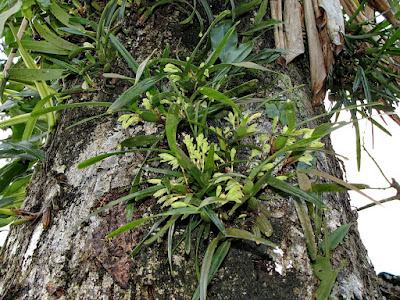Maxillaria anceps - Double-Edged Maxillaria are 2.5 cm in diameter, slightly fragrant, greenish. It is very similar to Maxillaria alba, but has fewer
Maxillaria anceps, also called as Double-Edged Maxillaria, Maxillariella anceps, is a species of the genus Maxillaria. This species was described by Oakes Ames and Charles Schweinfurth in 1930.
DESCRIPTION OF MAXILLARIA ANCEPS - DOUBLE-EDGED MAXILLARIA
Maxillaria anceps is native to Mexico (Oaxaca, Chiapas) to Central America. It is found growing on tree trunks and larger branches in wet forests in Costa Rica, Guatemala, Honduras, Mexico Southeast, Mexico Southwest, Nicaragua at elevations of 1200-1500 meters above sea level.
It is a small to large sized, cool growing epiphyte which reaching up to 90 cm in height with thick, somewhat compressed, elongated rhizome that are covered with brown, truncate and imbricate sheaths. The pseudobulbs are unifoliate, laterally compressed, ancipitous, longitudinally ridged, ovate, partially enveloped basally by several, imbricating, scarious, leaf-less sheaths. The single leaf is apical, linear-ligulate, obliquely retuse apically and conduplicate below into the short, petiolate base, up to 30 cm long.
Double-Edged Maxillaria blooms in winter from the basal, through the leafless sheath, 5 cm long, single flowered inflorescence that arising on the newest mature pseudobulb. The flowers are 2.5 cm in diameter, slightly fragrant, greenish. It is very similar to Maxillaria alba, but has fewer flowers, which open less and are more green.
MAXILLARIA ANCEPS - DOUBLE-EDGED MAXILLARIA CARE AND CULTURE
Cultural information should only be used as a guide, and should be to be adapted to suit you. Your physical location; where you grow your plants, how much time you have to devote to their care, and many other factors, will need to be taken into account. Only then can you decide on the cultural methods that best suit you and your plants.
Light:
Maxillaria anceps needs a light level of 20000-30000 lux. Moderately bright light should be filtered or dispersed, the plants should never be exposed to the direct effects of the midday sun. The strong air movement should be ensured at all times.
Temperature:
The average temperature of the summer day is 22-24 °C, night 13-15 °C with daily amplitude of 8-10 °C. If a cooling air humidifier is used, the plants will grow well near the cold, moist outlet. In winter, the average day temperatures are 19-21 ° C, and the night around 9-10 ° C with the daily amplitude of 8-9 ° C.
Humidity:
Double-Edged Maxillaria needs the humidity of about 70-80% for most of the year. Too dry air has a negative effect on the development of the plant: its growth is inhibited, and the leaves begin to turn yellow and dry out. The higher temperature, the higher the humidity should be, and the higher the humidity, the more often and longer it is necessary to ventilate the room where the plants are contained, otherwise the probability of rotting and various kinds of fungal diseases. Good air movement is essential while the plants are in leaf and growing.
Substrate, growing media and repotting:
Maxillaria anceps can be grown both in pots with good drainage as well as mounted on a piece of cork oak or tree fern. However, it should be remembered that in the second case the plants require high humidity, and during hot and dry weather it may be necessary to water several times each day.
For this reason, it is easier to grow in pots or hanging baskets filled with very loose, quickly drying substrate. The most commonly used growing medium is medium-sized fir bark or shredded tree-fern fiber with the addition of coarse pearlite to keep the substrate cool while providing the right amount of moisture. The addition of charcoal also has a positive effect on the structure of the substrate and prevents its acidification.
The plants should be repotted immediately if the substrate is decomposing or when the pot is too small. Repotting is best done at the time of emergence of new roots, which guarantees that the plant will regenerate its strength in the shortest possible time.
Watering:
Double-Edged Maxillaria should be watered frequently while they are actively growing, but there should be excellent drainage and the roots need to dry out quickly after watering. When the new growths reach maturity in the fall, the amount of water should be reduced.
Fertilizer:
During the period of active growth, the plants should be fertilized every week with 1/4-1/2 doses of fertilizer for orchids. You can use sustainable fertilizer throughout the year, but also can use a high nitrogen fertilizer from spring to mid summer, then in late summer and autumn use fertilizer with a predominance of phosphorus.
Rest period:
Maxillaria anceps does not need a rest period in winter, and such conditions should be maintained throughout the year. In winter, the amount of water should be reduced somewhat, especially if the plants are grown in cooler conditions, or in the darker, short day conditions, but the plants should never be completely without water. Fertilization should be reduced or eliminated until new growths appear and watering begins more abundantly in the spring.















COMMENTS